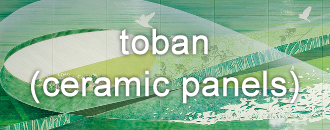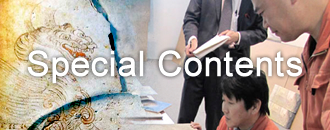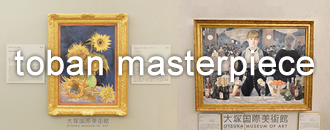Home > Special Contents > Reproduction of Kitora Tomb Stone Chamber
- Special
Contents - 01
Reproduction of Kitora Tomb Stone Chamber
"toban"/ceramic panels with extraordinary durability and expressive ability.
A major project commissioned by the Agency for Cultural Affairs of Japan.
The "Kitora Tomb Stone Chamber" is well-known by every Japanese . On the celing and the four walls of the stone chamber excavated in Asuka Village of Nara Prefecture, drawings of astronomical charts, four gods, 12 figures with the heads of the animals from the Chinese zodiac, etc. are depicted. It is a valuable cultural asset considered to have been made around the beginning of the 7th or 8th century. At the time of its discovery, with the murals already suffering and risking from severe deterioration such as the drawings flaking off from the walls, the original murals were immediately removed for preservation and restoration.
The Agency for Cultural Affairs, after its decision to have a reproduction made to pass on this valuable cultural asset in its original size and condition to future generation, has exclusively commissioned to Otsuka Ohmi Ceramics for its "toban" ceramic panels proving extraordinary durability, semi-permanent discoloration and the commitment to faithfully reproduce exactly as the original walls. Otsuka Ohmi Ceramics' accumulated achievements were recognized through the reproduction of numerous art masterpieces, murals, etc. that are displayed at the Otsuka Museum of Art. Unlike in the past, this project led to a new level of challenge for Otsuka Ohmi Ceramics.
Review of 30,000 image data. Repeated discussions with specialists to recreate the special ambience of stone chamber.
The reproduction work had begun with the overwhelming number of data provided by the Agency for Cultural Affairs that consisted approximately 30,000 images. The toban/ceramic panels and original murals were laid out side-by-side to make comparative verification and prototypes were repeatedly reproduced. In order to comprehend the raw conditions that could not be grasped from image data, numerous interviews with experts from the Reproduction Committee appointed by the Agency for Cultural Affairs and the staff involved in the actual removal of the murals were conducted.
We pursued a high degree of perfection by holding repeated meetings with the various experts about the peeling of mural details at the time of discovery, the plant root that entered the stone chamber, the hues of the ceiling which had higher moisture content and suffered greater discoloration than the other walls, etc.
Various prototypes are displayed at our Shigaraki showroom exemplifying the enthusiastic exchanges of that time.
Experienced artisans give final hand touch up to subtle colors and robust expressions distinctly reproduced on the wall surfaces.
The surface of the Kitora Tomb murals, subject to the area of the surface, the wall expression can totally change. The particle size of the decorative clay base were adjusted to reproduce subtle changes in expression. Further, the surface irregularities or the carved lines of the draft sketch of the mural were carefully created using knives or spatulas. Lights were always on during production as it was necessary to compare the shadows as shown on the original photograph were evenly made on the reproduction.
Color analysis were conducted with the supplied image data. The analyzed color is transformed to create ceramic paint. By using ceramic color paint on the bare ceramic panel before firing, the same imagery as the data will be transferred to the fired toban. One of the characteristics of ceramics is that the color expressions before firing and after firing are different, but relying on long years of experience and sense to imagine the color after firing, artisans performed color overlaying and firing repeatedly to bring the results closer and closer to the original. The "toban"/ceramic panels of Otsuka Ohmi Ceramics are highly durable to heat and can withstand the repeated firings as colors are overlaid, enabling even more faithful reproduction of color tones.
Acclaimed highly for the perfection so close to the original.
Setting a new standard procedures on how to record, preserve and utilize future cultural assets.
After overcoming innumerable difficulties, the reproduction of the Kitora Tomb Stone Chamber was completed in 2010. We received high praise from the experts, with such comments as "It reminds me of the initial condition inside the stone chamber." and "This reproduction will have great potential to record and preserve cultural assets that cannot be moved." The original stone chamber was reburied in 2013 and the appearance of the stone chamber space before the Kitora Tomb murals flake away can only be seen through this "toban" reproduction.
Even if the original stone chamber was to be opened to the public, the cultural asset will most likely be restricted not to go near nor be touched. With the "toban" reproduction, on the other hand, you can enter the stone chamber, experience the size of the space, and even touch the walls to feel the raised plasters as well as the fine surface irregularities of the 12 zodiac figure lines.
So far, the toban reproduction of the Kitora Tomb Stone Chamber has been exhibited in various regions of Japan. Because of the great value as a cultural asset, learning through physical touch of the object bring greater experience and significant meaning than viewing items that are preserved and observed through glass cases.
Photo Gallery of completed reproductions
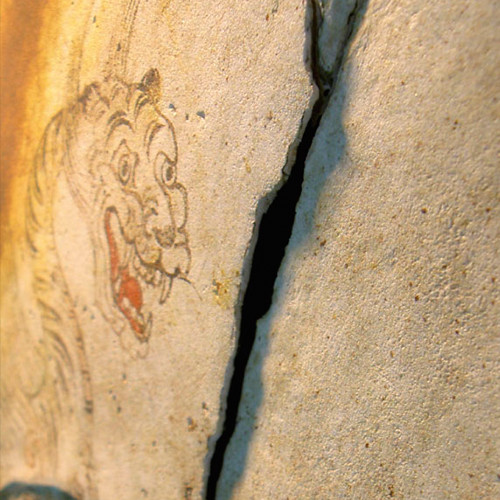 Irregularly raised plaster
Irregularly raised plaster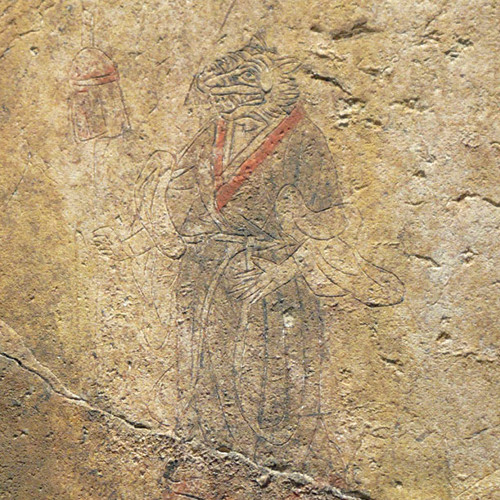 Details of engraved lines of sketch drawings (Tiger)
Details of engraved lines of sketch drawings (Tiger)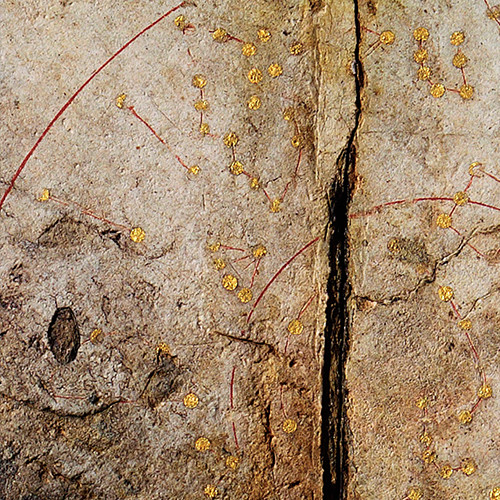 Astronomical chart (Ceiling)
Astronomical chart (Ceiling)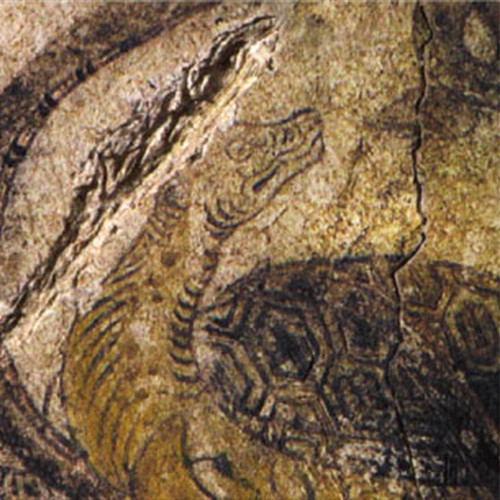 Black Tortoise (partial)
Black Tortoise (partial)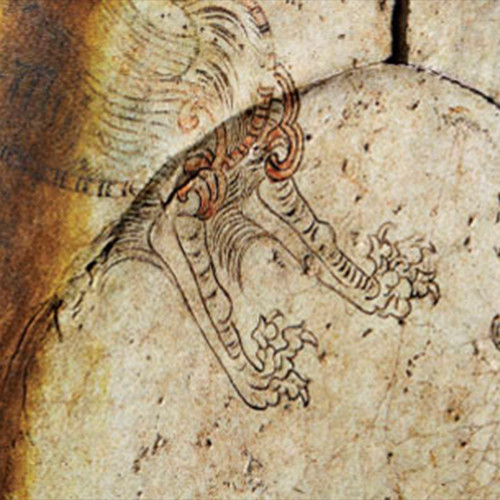 White Tiger (partial)
White Tiger (partial)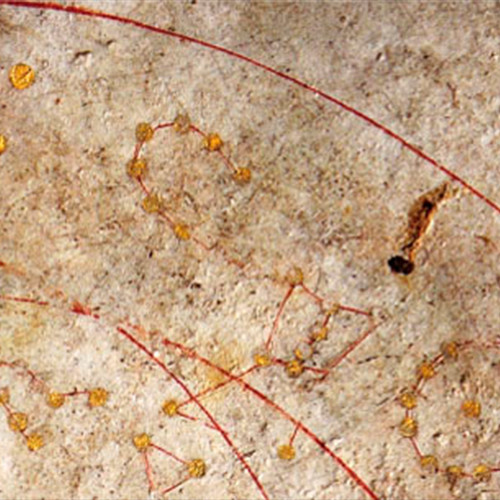 Astronomical chart (partial)
Astronomical chart (partial)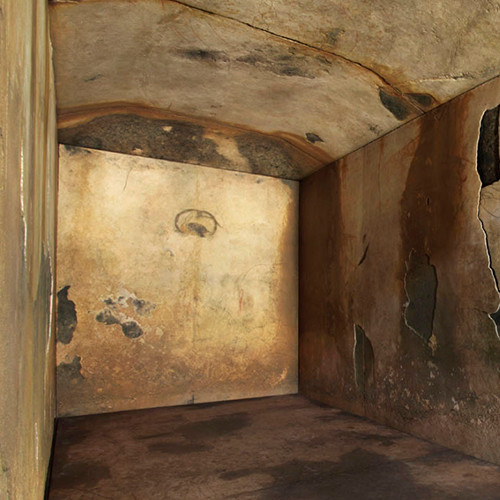 Inside of the reproduced stone chamber
Inside of the reproduced stone chamber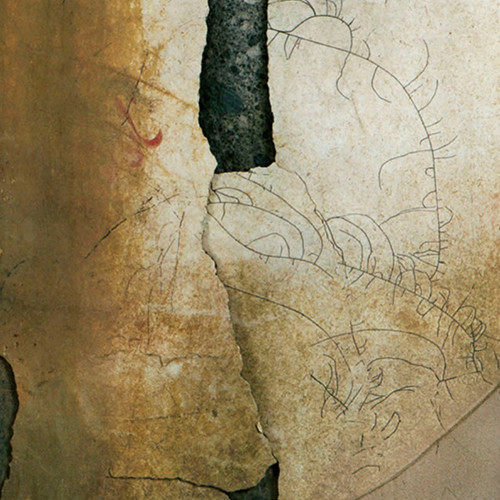 East wall
East wall
